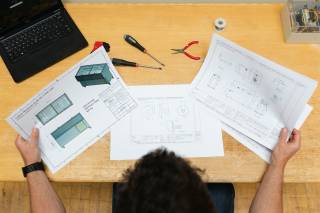Creating a ‘real-life’ scenario assessment project for MEng students
This case study explores how staff and students collaborated to create a new form of assessment for the BARC0132 module, with emphasis on familiarising students with Eurocode regulations.
13 July 2021
Case study by Manuela Sadik
What was the aim of your project?
Students taking the BARC0132: Structural and Foundation analysis module are required to participate in a structural design project as part of their final assessment. To improve their learning experience during this project, we aimed to create new teaching materials such as an interactive ‘real-life’ scenario as well as improve existing teaching materials.
What did you do?
At the start of the project, we distributed a project handout to students studying the BARC0132 module. The handout provided the basic parameters of a real building, including it’s architectural characteristics and location as well as local conditions such as exposure and soil. From there, students had to explore and navigate common design choices and challenges to create a satisfactory building design via an iterative process. This involved proposing and testing several possible solutions to structural challenges to comply with code-based limit states.
At the project’s conclusion, the students were required to present their design to ‘stakeholders’ using a powerpoint presentation, fifteen minute video and written report outlining their design choices and process. In this scenario, the ‘stakeholders’ were the academics who were grading them.
As well as designing the handout and scenario, we recorded video tutorials to help the students (e.g. on how to use Eurocodes when defining load demands or checking structural capacity). Several Q&A sessions were also held to further guide the students through the analysis, modelling and design process.
How did you work with others on this project?
I was in charge of creating the basic guidelines for the scenario handout, developing the tutorial video, providing support during the Q&A sessions and providing general feedback on the final presentations. Dr Fabio Freddi collaborated in the design of the scenario experience, provided technical supervision for the video tutorials and directed the Q&A sessions. As the head of the course, he was also in charge of setting the grading scales and requirements for the deliverables.
What was involved in terms of approach, logistics, time and resources?
Due to the current COVID-19 pandemic, the project was performed virtually/remotely. Designing the scenario took approximately five hours. Creating the video tutorials, which included the development of supporting materials as well as the recording, editing and publishing of the videos, took around thirty hours. This was reflected in four hours of streaming content. The Q&A sessions were another six hours. Finally, around eight hours of team meetings were required for the planning, execution and discussion of the project.
How has this project improved the student learning experience?
The learning experience in engineering is often limited to the acquisition of knowledge. However, engineering professionals are required to have many other skills that are not usually taught during their formative years (e.g. team-working skills or decision-making). Through this project, students were able to experience some of the most common challenges faced in the industry and use their own initiative to solve them. The collaborative nature of the project also meant that students had to learn how to efficiently communicate their ideas to both stakeholders and their teammates. Such experiences throughout the project provided students with the opportunity to develop some of the untaught skills that are crucial when working as an engineering professional.
 Close
Close


